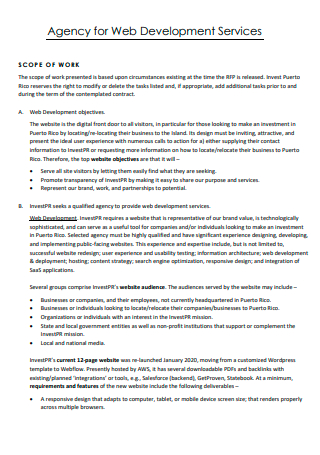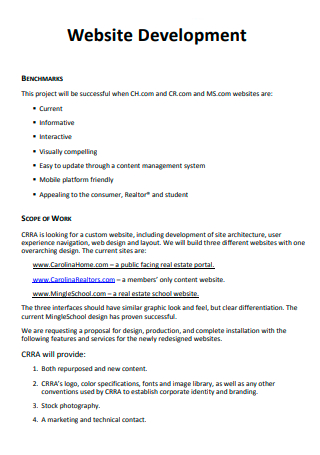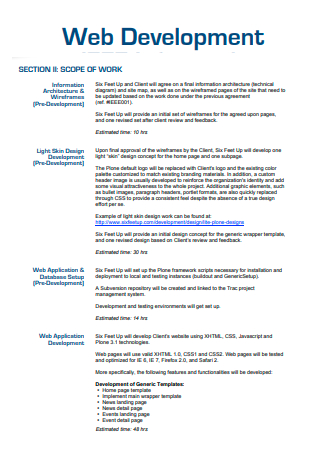3+ Sample Web Development Scope of Work
FREE Web Development Scope of Work s to Download
3+ Sample Web Development Scope of Work
What Is Web Development Scope of Work?
What Is Web Development?
What Is the Importance of Web Development Scope of Work?
What Are the Duties of a Web Developer?
What Are the Types of Web Developers?
How To Become a Web Developer:
FAQs
How Much Do Web Developers Make?
Can Anyone Be a Web Developer?
Can I Teach Myself Web Development?
Taking a good read about the Web Development Scope of Work will definitely bring you to a better level of understanding about how web development works. Read on to know more.
What Is Web Development Scope of Work?
A website development scope of work is a document that web developers send to clients to provide details on a specific project and its requirements. Once signed, it is a legally binding document that helps both parties avoid conflict, minimize misunderstandings, and stay on the same page. This includes the following:
Project Summary
This is the first section of your scope of work template. Use this section to offer a brief and concise overview of the project at hand. Think of project objectives, background information, requirements, and problems before writing this section. A detailed project summary shows your understanding of the website project requirements and lets prospects know you have got everything under control.
Project Goals
Project goals clarify what website issues you are being brought in to resolve. They also show how a new project ties to the bigger organizational goal, like content marketing, new feature launch, or a sales campaign–an important consideration when drafting your scope of work. Think of these goals as tangible results that a project needs to achieve. Consider making these goals Specific, Measurable, Achievable, Relevant, and Time-bound (SMART) for project success.
Here is what they could look like:
- Specific: add six new pages to the website
- Measurable: reduce the site speed by 15%
- Achievable: create two new pages every month
- Relevant: help the product marketing team to improve conversion rate by 25%
- Time-bound: complete the whole project within next three months
- Having crystal-clear goals like these will help you stay focused throughout the project and deliver the final website on time.
Project Scope
This section helps you set clients’ expectations regarding what they can expect from you during the website project. Think of project scope as a detailed description of resources, timelines, deliverables, and project boundaries. Web developers can also add processes, assumptions, and foreseeable challenges in this section.
Here is what you can add in the written scope:
- Work breakdown structure: that divides bigger tasks into manageable chunks
- Scope exclusions: these will not be part of the project deliverables
- Acceptance criteria: that spells out how both parties will determine project success
- Ensuring you have got all of this on your scope of work sets you up for a successful web development agreement.
A clear website development scope of work lays the foundation of a new project by outlining important deadlines, deliverables, and key expectations, all you need to do is tweak it per client. It helps the client clarify expectations, visions, and responsibilities at the beginning of a project.
What Is Web Development?
Web development refers in general to the tasks associated with developing websites for hosting via intranet or internet. The web development process includes web design, web content development, client-side or server-side scripting and network security configuration, among other tasks. In a broader sense, web development encompasses all the actions, updates, and operations required to build, maintain and manage a website to make sure of its performance, user experience, and speed are optimal. Additionally, it might also, but not necessarily, include all those strategic actions needed to ensure its proper ranking on search engine results. Usually, those tasks pertain to a different specialization, namely search engine optimization (SEO) marketing strategy.
Web development is also known as website development, while the professionals that maintain a website are called web developers or (more commonly) web devs. Web development is the coding or programming that enables website functionality, per the owner’s requirements. It mainly deals with the non-design aspect of building websites, which includes coding and writing markup. Web development ranges from creating plain text pages to complex web-based applications, social network applications and electronic business applications. The web development hierarchy is as follows:
- Client-side coding.
- Server-side coding.
- Database technology.
What Is the Importance of Web Development Scope of Work?
Discussing these factors will help ensure both parties are on the same page about the work agreement. When it comes to web development, you want to discuss:
- Website requirements: that list out desired features, functions, and specifications
- User interaction: defines how end-users will be using the website
- Communication with stakeholders: specify whom you expect feedback from at different phases
- Limitations: that mention what cannot be achieved in this project
- Management: to have processes in place for managing disagreement and changes in the scope of work
Including all the fine details makes sure you are creating a scope of work that has you covered at all steps. That is what this document does, after all–it protects you from project-related issues or disagreements. Plus, it enables you to answer questions your client may have about what you’re about to take on.
It is in both yours and the client’s best interest to get everything down on paper–be that the payment schedule or the expected finish date. If it is in the signed scope of work, you are both held to it, and understand it.
What Are the Duties of a Web Developer?
Web developers build websites and ensure they perform reliably and efficiently. Learn more about this critical role in the tech industry and how to get started. As a web developer, you could work for a company or agency, or as a freelancer taking on projects for individual clients. Your tasks will vary depending on your work situation, but day-to-day responsibilities might generally include:
- Designing user interfaces and navigation menus
- Writing and reviewing code for sites, typically HTML, XML, or JavaScript
- Integrating multimedia content onto a site
- Testing web applications
- Troubleshooting problems with performance or user experience
- Collaborating with designers, developers, and stakeholders
Many web developers start their careers with a single focus, usually front-end or back-end development. They may move on to be full-stack developers or explore careers in related fields, including project management, computer programming, or graphic design.
What Are the Types of Web Developers?
Web developers usually fall under one of three categories: back-end developers, front-end developers, and full-stack developers. Some web developers also work as webmasters. Take a closer look at each of these roles:
How To Become a Web Developer:
A formal education is not always necessary to become an entry-level web developer. Some web developers have an associate’s or bachelor’s degree in website design or computer science, but others teach themselves how to code and design websites. While earning a degree can make you a more competitive candidate, a strong portfolio can go a long way toward validating your skills to potential employers. If you are interested in becoming a web developer, here are some steps you can take.
Step 1: Build Web Developer Skills
Employers and clients usually expect web developers to have certain skills that demonstrate their ability to deliver on website requirements. If you are interested in a career as a web developer, these are some skills you can focus on to build a foundation for success.
Technical Skills
- Coding: Common programming languages include HTML, PHP, cascading style sheets, and JavaScript for front-end design. Consider learning Python, Java, or Ruby if you want to do back-end development.
- Responsive design: People use a variety of devices to view websites. Developers should be able to create sites that look as good on smartphones and tablets as they do on computer screens.
- Technical SEO: Many factors of website design can affect the site’s search engine ranking. Understanding how search engines rank sites is useful in a developer’s work.
- Version control: This lets you track and control changes to the source code without starting over from the beginning each time you run into a problem.
- Visual design: Understanding basic design principles, such as how to use white space, choose fonts, and incorporate images could boost your marketability.
Workplace Skills
- Communication: Web developers spend time discussing design ideas with their clients and team members through each step of the project.
- Customer service: A web developer creates websites for the client to use and should remain client-focused to achieve the best results.
- Detail-oriented: Small details, like a small change in code, can make a big difference in how a website performs.
- Organization: Keeping track of deadlines, project tasks, workflow, and budgets is helpful if you want to complete a website design on time.
- Problem-solving: Web developers often run into issues when designing websites. They should have the patience and ability to identify problems in the design or coding and solve them in a methodical way.
Step 2: Consider a Degree in Computer Science or Web Design
While you do not always need a degree to get a job in web development, it can certainly help. If you are already in school (or considering earning a degree), some majors might be a better fit for your career goals than others. If you are more interested in back-end web development, consider a degree program in computer science. If you feel more drawn to front-end development, you might opt for a degree in web design or user experience (UX).
Step 3: Take a Course in Web Development
You do not necessarily need formal training to work as a web developer. It is possible to acquire the skills you need on your own. For instance, you can take a course to learn programming languages like HTML, JavaScript, or CSS, and then put what you learn into practice on your own website. By completing an online course in web development, like Web Design for Everybody: Basics of Web Development and Coding from the University of Michigan, you can build skills while completing development projects for your portfolio.
Step 4: Built a Portfolio of Web Development Work
As a web developer, your portfolio is often one of the most important parts of your resume. This collection of projects shows potential employers what you are capable of creating. Include the types of projects that represent the work you’d like to do. If you’re including code, be sure to annotate it to show your thought process.
Step 5: Get Certified
You will find a range of general and vendor-specific options, including Adobe Certified Expert (ACE), Microsoft Certified Solutions Associate (MCSD), Amazon Web Services (AWS) Certified Developer, or Zend Certified PHP Engineer. Earning a certification can validate your skill set to potential employers.
FAQs
How Much Do Web Developers Make?
How much you earn will depend on many factors, including where you work, what industry you work in, and how much experience you have. The median annual salary for web developers in the US is $77,200, according to the Bureau of Labor Statistics (BLS). Top earning web developers can sometimes make over $120,000 per year. Current projections show faster than average growth of these jobs through 2030, according to the BLS. One of the driving forces behind this increase in web development jobs is the growth of e-commerce. Companies are becoming more reliant on functioning websites that operate on multiple devices to do business.
Can Anyone Be a Web Developer?
Anyone can become a web developer. You do not need to be a tech wizard or possess a never-ending list of formal qualifications; as long as you are passionate about the field and willing to learn, a career in web development is well within your reach.
Can I Teach Myself Web Development?
Yes, it is absolutely possible to self-learn Web Development. To learn web-development one would need to master its two aspects – front-end and back-end.
While web development typically refers to web markup and coding, it includes all related development tasks, such as client-side scripting, server-side scripting, server and network security configuration, ecommerce development, and content management system (CMS) development.
While learning about web development is kind of like drinking from a fire hose. Google “coding,” and you have turned the hose on full blast, this guide serves as a slow drip to get you acquainted with and intrigued by the world of web development. It is by no means a comprehensive manual.
This guide covered the basics of web development, the process of creating a website, and additional resources for those who want to learn more about development — or become a developer themselves. For more details, you may look at the samples in this article.




